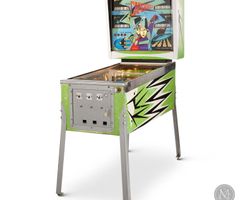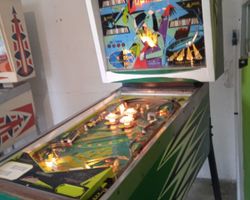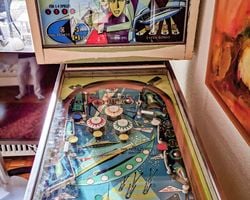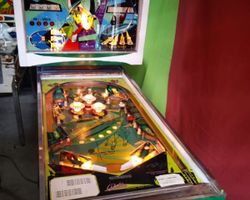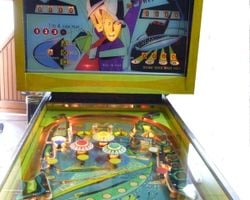Capersville
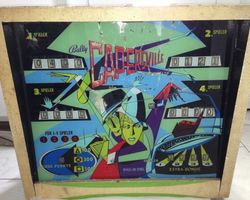
Average Prices: USD $300 to $1,200
Produced: December, 1966
Production Run: 5,120 units
Machine Type: Electro-mechanical
Players: 4
Design by: Ted Zale
Art by: Jerry Kelley
Capersville, a compelling electro-mechanical (EM) pinball machine from Bally Manufacturing Corporation, debuted in December 1966. Its arrival marked a significant point in pinball design, bringing together innovative mechanics and a distinctive artistic vision. The machine was the brainchild of Ted Zale, who served as the singular force behind its design, concept, animation, and mechanical engineering. Zale's comprehensive involvement ensured a cohesive and forward-thinking experience that would differentiate Capersville from its contemporaries.
The visual identity of Capersville, particularly its backglass, was crafted by artist Jerry Kelley. Kelley drew inspiration from the 1965 French detective film 'Alphaville', starring American actor-singer Eddie Constantine. This influence is discernible in the artwork, with the central figure on the backglass directly referencing Constantine's portrayal. This artistic choice infused the machine with a sophisticated, somewhat mysterious tone, aligning with a spy or secret agent theme without overtly stating it. Bally produced 5,120 units of Capersville, making it a moderately available machine for its era, designed for up to four players. The design and production process, led by Zale's singular vision, aimed to push the boundaries of EM gameplay, incorporating features that would become standard in later decades.
Signature Features and Design
Capersville distinguishes itself through several unique elements that fundamentally alter the gameplay experience. Foremost among these are the Zipper Flippers, a mechanical innovation allowing the two flippers to close together, creating a larger, central barrier. This feature adds a strategic dimension, enabling players to trap the ball or direct it with precision into specific scoring areas, a departure from traditional open flipper setups.
Another standout element is the machine's pioneering approach to multiball. Capersville features not one, but two distinct multiball modes, including a 3-ball multiball, a complex offering for an EM game of its time, previously seen on Bally’s 1963 ‘Star-Jet’. Balls are held in kick-out holes before being released for simultaneous play. The design also incorporates a captive ball walker with a carry-over feature, which is integral to game progression. This system, involving an upper right ball return gate that feeds into a four-step captive ball alley, allows a player's progress in this area to persist across multiple games or even between players in a multi-player session. The playfield is adorned with three pop bumpers and six mushroom bumpers, creating a lively upper playfield environment. These features, combined with Jerry Kelley’s unique "pointy people" art style, contribute to an aesthetic that some describe as "angle art" and a visual signature of the era.
Playfield and Mechanics
The Capersville playfield is a carefully constructed environment designed to encourage strategic play and high scoring. The layout is dominated by the two Zipper Flippers at the bottom, which, when activated, merge to form a single, wider barrier. Above these, a single slingshot is positioned to the left, a design choice that adds to the distinct feel of the lower playfield.
The upper playfield is bustling with activity, featuring an array of pop bumpers and mushroom bumpers that keep the ball in motion and generate points. Two kick-out holes are strategically placed, crucial for initiating multiball sequences by holding balls before releasing them into play. A key mechanism is the left ball kicker lane, which shoots the ball to the top of the playfield, resetting its journey and opening up new scoring opportunities. On the upper right, the ball return gate leads into the Deep Caper Alley, a unique four-step captive ball alley. This alley is not just a scoring feature; its carry-over mechanism allows progress to persist, influencing subsequent games or turns.
The artwork on the playfield, consistent with the backglass, employs Kelley's distinct "pointy people" style, creating an intriguing, almost abstract world for the pinball to navigate. The lighting is functional, highlighting scoring areas and features, guiding the player's focus through the complex layout. The overall aesthetic is one of mystery and intrigue, inviting players to unravel the secrets of Capersville. This design philosophy creates a dynamic and challenging experience where careful aim and strategic use of the flippers are paramount to success.
Gameplay Dynamics
Capersville offers a nuanced gameplay experience, characterized by a surprisingly deep ruleset for an EM machine. The primary objective revolves around maximizing points, with the maximum displayed score reaching 9,999 points per player. The game's scoring system rewards precision and strategic engagement with its various features.
A central element of Capersville's appeal is its innovative multiball play. The machine supports 3-ball multiball, a rare and thrilling event in the EM era. Players typically initiate multiball by locking balls in the kick-out holes, demanding skillful shots. A unique aspect in multiplayer games is the ability to "steal" multiballs from other players, fostering a competitive dynamic. The captive ball walker, particularly the Deep Caper Alley, offers a four-step progression that can carry over from game to game. Completing these steps or advancing the captive ball awards points and can contribute to special awards or replay opportunities, adding long-term strategic depth.
The Zipper Flippers introduce a strategic layer to shot-making. Players can use them to trap the ball, then release it for specific shots, or attempt to guide the ball through the narrowed opening for high-value targets. The single left slingshot means that the right side of the playfield behaves differently, requiring players to adapt their shot angles. The game also incorporates various skill shots, such as accurately propelling the ball into specific lanes or targets to maximize initial scoring or to set up subsequent playfield features. While the 'Code Zapper' score might have an element of randomness, the core gameplay rewards precision, exploration of the rule set, and adaptive strategies, contributing to its enduring replayability.
Reception and Legacy
Capersville has garnered a largely positive reception within the pinball community, often celebrated for its forward-thinking design. Its most frequently cited strength is its innovative gameplay, particularly the sophisticated implementation of multiball modes and the strategic advantage offered by the Zipper Flippers. Many pinball enthusiasts regard these features as remarkably advanced for a 1966 EM machine, describing them as "ahead of its time." The machine's complex ruleset, demanding exploration and mastery, also contributes significantly to its enduring appeal, fostering replayability that transcends the typical EM experience. The ball lock mechanisms, particularly the carry-over feature of the captive ball alley, are frequently praised for adding layers of strategy and depth.
However, the machine’s artwork by Jerry Kelley often sparks debate. While some enthusiasts appreciate its unique "pointy people" style, seeing it as "fantastic" and an integral part of the machine's character, others find it "basic and bland," or even "bizarre." This subjective aspect of the art is one of the few points of contention among otherwise positive feedback. Another aspect frequently mentioned is the machine's difficulty. Capersville is often described as "tough to master" and "not approachable at ALL to novices." This can lead to short game times for new players and initial frustration, yet for experienced players, this challenge is precisely what makes the game so rewarding and engaging. Specific criticisms occasionally surface regarding the absence of a right slingshot, which alters ball physics and scoring opportunities, and the mechanics of the Deep Caper Alley under certain conditions. The machine's sound profile is also noted as being primarily mechanical, lacking the chimes or electronic sounds found in later machines.
Despite these minor points of contention, the overall sentiment towards Capersville remains overwhelmingly positive. It is widely considered a notable achievement in EM pinball design, with its innovative features influencing later machines and solidifying its place in pinball history. Its reputation as a challenging yet deeply rewarding game has ensured its status as a highly sought-after machine for collectors and a "must-play" for pinball enthusiasts seeking a profound EM experience.
Sponsored Links
 Ebay Listings
Ebay Listings
 Auction Results
Auction Results
| Cost | Location | Date |
|---|---|---|
| EUR €900 |  Niedersachsen, Germany Niedersachsen, Germany |
22 August, 2024 |
| EUR €950 |  Niedersachsen, Germany Niedersachsen, Germany |
03 July, 2024 |
| GBP £800 |  Walsall, United Kingdom Walsall, United Kingdom |
21 February, 2024 |
| GBP £800 |  Walsall, United Kingdom Walsall, United Kingdom |
29 January, 2024 |
| GBP £800 |  Walsall, United Kingdom Walsall, United Kingdom |
14 January, 2024 |
| CAD $1,400 |  Canada Canada |
09 December, 2023 |
| GBP £800 |  Walsall, United Kingdom Walsall, United Kingdom |
04 December, 2023 |
| GBP £1,295 |  United Kingdom United Kingdom |
23 August, 2023 |
| USD $1,495 |  California, United States California, United States |
04 April, 2023 |
| USD $1,300 |  Texas, United States Texas, United States |
03 November, 2022 |


Private Policy · Search Website · Contact Us
As an eBay Partner, we may earn a commission from qualifying purchases made through links on this site, at no additional cost to you.
All trademarks and copyrighted materials remain property of their respective owners. All other content copyright 2007 - 2025 Pinpedia.

